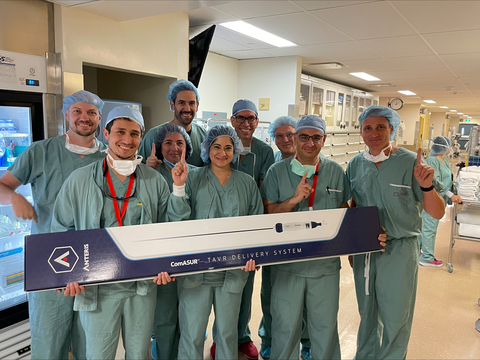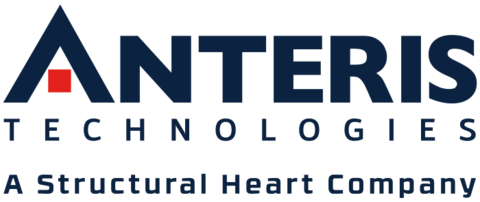BRISBANE, Australia & MINNEAPOLIS--(BUSINESS WIRE)--Anteris Technologies Ltd, (Anteris or the Company) (ASX: AVR), a structural heart company developing DurAVR™ THV, a new class of biomimetic heart valve and the world’s only balloon-expandable, single-piece transcatheter aortic valve shaped to mimic the performance of a native human aortic valve, announces that the DurAVR™ THV was used for the first time in a valve-in-valve (ViV) procedure as part of Health Canada’s Special Access Program (SAP).
A ViV procedure is required for patients with a life-threatening situation wherein their current bioprosthetic aortic valve is failing due to calcification or structural deterioration, and a new heart valve must be implanted inside the failing valve. These patients are at high risk for another surgery and require a minimally invasive treatment option. Canada’s SAP exists so that life-saving technology not currently available for commercial use in Canada can be provided when no other commercially available alternatives are suitable.
Dr. Anita Asgar, Co-Director of the Structural Heart Program at the Institut de Cardiologie de Montreal (Montreal, Canada), made the request to Health Canada to use the DurAVR™ THV in a patient with a failing valve that needed optimal hemodynamic results as well as a short frame height as they were very high risk of poor hemodynamic result with a conventional ViV procedure. Dr. Asgar performed the procedure on an 84-year-old male and implanted a DurAVR™ THV inside the failed surgical aortic valve replacement (SAVR).
The procedure was successful. The hemodynamic performance of the valve was outstanding in such a complex patient. The patient had an 88% reduction in mean gradient which brought the patient back to a near-normal physiologic state, with a final gradient of only 6mmHg after deploying the valve. These results mirror what DurAVR™ THV has seen in its extensive ViV bench-top studies.
Dr. Asgar commented:
“The DurAVR™ THV provided a life-saving solution for a patient requiring a new valve to be implanted without compromising hemodynamic performance or future coronary access. These hemodynamic results are not seen with currently available products, which is important as there is a large need for a valve that can offer optimal hemodynamic performance in the valve-in-valve setting, particularly with a shorter frame height. Additionally, despite this being an incredibly complex case, using Anteris’ ComASUR™ delivery system and deploying the valve was remarkably easy. The unique design of DurAVR™, including the low frame height and the single-piece design, makes the valve well-suited to address the needs of valve-in-valve patients.”
Chris Meduri, Anteris Technologies CMO, commented:
“This successful procedure further validates our extensive pre-clinical work in valve-in-valve as well as our extensive clinical experience in native aortic stenosis. This signals the viability of a purpose-built valve designed to achieve life-saving outcomes in a patient population currently treated with tradeoffs in mind. Eliminating that compromise would be widely beneficial to a rapidly growing population of patients whose current valve is failing.”
About Anteris Technologies (ASX: AVR)
Anteris Technologies (ASX: AVR) is a structural heart company committed to designing, developing, and commercialising innovative medical devices. Founded in Australia, with a significant presence in Minneapolis, MN – a US MedTech hub, Anteris is science-driven, with an experienced team of multidisciplinary professionals delivering transformative solutions to structural heart disease patients.
The Company’s lead product, DurAVR™ THV, is a first-in-class biomimetic transcatheter aortic valve for the treatment of aortic stenosis (AS). The DurAVR™ THV, in concert with the ComASUR™ Delivery System, is designed to achieve pre-disease hemodynamic performance leading to improved clinical outcomes.
DurAVR™ THV has been designed in partnership with the world’s leading interventional cardiologists and is the first transcatheter aortic valve replacement (TAVR) to use a single piece of bioengineered tissue. This first-in-class biomimetic valve is uniquely shaped to mimic the performance of a healthy human aortic valve.
Anteris’ patented anti-calcification ADAPT® tissue technology has been used clinically for over 10 years and distributed for use in over 50,000 patients worldwide.
The ComASUR™ Delivery System is designed to provide controlled deployment and accurate placement of the DurAVR™ THV with balloon-expandable delivery, allowing precise alignment with the heart’s native commissures to achieve desired valve positioning.
Aortic stenosis is a common and serious valvular heart disease. It is the narrowing of the aortic valve, reducing blood flow from the heart as it opens. This means the heart must work harder to push the blood needed to function. Severe AS affects an estimated 3.4% of those aged ≥75 years in Europe and the USA.1 In Australia, an estimated 150,000 people suffer from moderate to severe AS, with the figure projected to climb to 200,000 by 2031 due to the aging population.2 The global TAVR market is estimated to be USD 10 billion by 2028.
Anteris Technologies is set to revolutionize the structural heart market by developing clinically superior solutions to meet significant unmet clinical needs.
- Aortic Stenosis in the Elderly: Disease Prevalence and Number of Candidates for Transcatheter Aortic Valve Replacement: A Meta-Analysis and Modelling Study. Journal of the American College of Cardiology, 62(11), 1002-1012. https://doi.org/10.1016/j.jacc.2013.05.015
- Baker Heart and Diabetes Institute. (2018). Whitepaper: Our Hidden Ageing. Retrieved from Baker Heart and Diabetes Institute: https://baker.edu.au/impact/advocacy/valve-disease
About Valve-in-Valve
ViV procedures represent an additional, rapidly growing patient population for the treatment of aortic stenosis. ViV procedures have increased more than 10 times from 2014 to 2019, representing about 6% of commercial transcatheter aortic valve replacement cases in the U.S.1 (Garcia, 2022).
- Garcia, S. (2022, 9 18). Fracturing Bioprosthetic THVs Shows Increased Mortality Risk, ‘Modest’ Hemodynamic Benefit, in ViV TAVR – Analysis. Retrieved from CRTonline.org: https://www.crtonline.org/news-detail/fracturing-bioprosthetic-thvs-shows-increased-mort
Authorization and Additional information
This announcement was authorized by Mr. Wayne Paterson, Chief Executive Officer.




